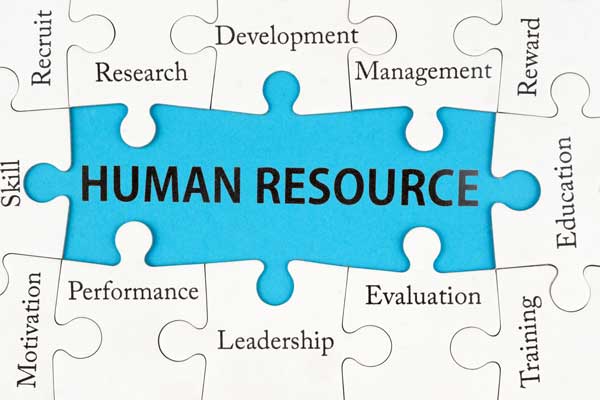Human resource management
Forecasting workforce requirements, over staffing, under staffing, and balancing the workforce, employee turnover, absenteeism, recruitment and selection of employees, training and development of employees, training need identifications, induction training, job skill training, group training and self learning systems, various methods of training, coaches to improve employee performance.
Forecasting workforce requirements
The first and most important job of human resource manager is forecasting the work force requirements for the organization. Forecasting or work force planning process includes:
- Workforce gap assessments
- Risks affecting the organisations Human Capital
- Recruitment – what should we be recruiting now to fill the short terms gaps?
- Development – what and who should be developed to fill gaps.
- Strategy – how we go about these activities for each department?
In appropriate forecasting can cause so many problems in the organizations. They are:
Inappropriate/appropriate human resource practices
| Over staffing | Numbers of people working are more that required; organizations pay for no work and involves in loss. |
| Under staffing | Numbers of people working are lesser that required; organizations putting pressures to employee for more work than they normally do. Organization quality decreases and employee are demotivated. Timely delivery of goods and services may not be possible so organizations images go down. |
| Employee turnover | Employee leaves the job, because they do not see the attraction. Job lacks motivational factors and hygiene factors. [number of employees left jobs/total number of employees in the jobs] |
| Absenteeism | Employees remain absent for many reasons. Job is not interesting, working environment is not good, they are not treated properly, |
| Balancing the workforce | Process of adjusting understaffing and over staffing, so that expenses due to the non-work, and quality can be reduced. |
Recruitment and selection of employees
| Recruitment | Process of making a roster of the candidates who can be employee of the organizations. (internal and external)
|
| Selection | Specialized task of selecting right people out of the names maintained in the roster.
The selection has several steps:
Qualities of selection tests
|
Training and development of employees
Training is a process whereby people acquire capabilities to aid in the achievement of organizational goals. Because this process is tied to a variety of organizational purposes, training can be viewed either narrowly or broadly. In a limited sense, training provides employees with specific, identifiable knowledge and skills for use on their present jobs. Sometimes a distinction is drawn between training and development, with development being broader in scope and focusing on individuals gaining new capabilities useful for both present and future jobs.
Types of Training
Training in organizations is offered in many different areas. Some of this training is conducted primarily in-house, whereas other types of training make greater use of external training resources.
Internal training: Training in on-the-job locations tends to be viewed as being very applicable to the job, it saves the cost of sending employees away for training, and it often avoids the cost of outside trainers. However, trainees who are learning while working can incur costs in the form of lost customers and broken equipment, and they may get frustrated if matters do not go well.
External training: External training occurs for several reasons:
- It may be less expensive for an employer to have an outside trainer conduct training in areas where internal training resources are limited.
- There may not be sufficient time to develop internal training materials.
- The HR staff may not have the level of expertise needed for the subject matter where training is needed.
- There are advantages to having employees interact with managers and peers in other companies in training programs held externally.
Training need identifications
Training need identification (TNA) is the most important jobs for any training. Without this training cannot be designed and delivered; if delivered it goes wastes.
Induction training, job skill training
Orientation or induction training is the planned introduction of new employees to their jobs, coworkers, and the organization. However, orientation should not be a mechanical, one-way process. Because all employees are different, orientation must incorporate a sensitive awareness of the anxieties, uncertainties, and needs of the individual. Most employers offer orientation in one form or another.
Jennifer Wilson, St. Louis regional vice president of Robert Half International says. “Orientation helps new employees become more comfortable in their new environment, which, in the long run, is going to lead to them contributing more quickly,”
Gains from orientation program
Employees are motivated through orientations because they feel comfortable. Through orientation;
- Employees know more about their position, the organization’s policies, administrative information, the better it allows them to focus on their role versus having to worry about extraneous details.
- Most importantly, it helps employees feel a sense of camaraderie.
- They feel as if they belong more quickly when they have been orientated to their new work environment.
Skill trainings
Employees need skills first to start work and then after regular updating of the skills. Some jobs like plumbing, cooking, electrician, driving, beautician, etc. are the skill-oriented jobs. Even for the managerial level, managerial skills are needed. There are different skill training institutions running; some are under government departments and some are as privately established institutions. Organizations can make agreement with them so that they help the organizations by imparting skills needed.
Group training and self-learning systems
T-group or training group (sometimes also referred to as sensitivity-training group, human relations training group or encounter group) is a form of group training where participants themselves (typically, between eight and 15 people) learn about themselves (and about small group processes in general) through their interaction with each other. They use feedback, problem solving, and role-play to gain insights into themselves, others, and groups.
A T-group meeting does not have an explicit agenda, structure, or express goal. Under the guidance of a facilitator, the participants are encouraged to share emotional reactions (such as, for example, anger, fear, warmth, or envy) that arise in response to their fellow participants’ actions and statements. The emphasis is on sharing emotions, as opposed to judgments or conclusions. In this way, T-group participants can learn how their words and actions trigger emotional responses in the people they communicate with. Many varieties of T-groups have existed, from the initial T-groups that focused on small group dynamics, to those that aim more explicitly to develop self-understanding and interpersonal communication. Industry also widely used T-groups, particularly in the 1960s and 1970s, and in many ways these were predecessors of current team building and corporate culture initiatives.
Self directed learning
Not all learning necessarily needs instructors. Many program instructions can be prepared to help the learners. From the computer on line course on can learn skills. Now sitting at home, one can have better university degrees.
Various methods of training,
| Types of training | Nature of Training | Problems with Training |
| Role Playing | Participants acting out roles in work-related situations can improve interpersonal skills. | Trainees may see it as a game not transferable to the job |
| Business Games | Computer simulations where the trainee makes management decisions and gets feedback on success. Trains people to make business decisions without actually affecting the business. | Training is expensive and time-consuming. |
| Sensitivity Training | Unstructured attempt to show how
others see individual. Can provide insight into interpersonal skills. |
Trainees may be personally “threatened” also may not be seen as job relevant. |
| Diversity Training | Classroom lecture approach to easing racial and gender tensions at work. | Training can create “backlash” or oversensitivity, inhibiting workplace interactions. |
| In-Basket Exercises | A series of memos or letters that must be dealt with, usually in a rapid fashion. Can be made relevant to real job decisions. | Training is time-consuming and must be tailored to jobs under focus. |
| Case Studies/ Incidents | Descriptions of real companies or situations that require dealing with a many facts and making decisions.
Can provide a great deal of exposure to many different companies and problems. |
Care must be taken to ensure that cases are relevant and problems are realistic. |
Coaches to improve employee performance.
Coaching aims to draw out a person’s potential rather than puts in aims and knowledge from outside. It develops rather than imposes. It reflects rather than directs. Effective coaching is a form of change facilitation – it enables people, rather than trains them.
Coaching maxims and principles
Typically, good coaches will use and follow these principles:
- Listening is more important than talking
- What motivates people must be understood
- Everyone is capable of achieving more
- A person’s past is no indication of their future
- People’s beliefs about what is possible for themselves are their only limits
- A coach must always provide full support
- Coaches don’t provide the answers
- Coaching does not include criticizing people
- All coaching is completely confidential
- Some people’s needs cannot be met by coaching , and coaches recognise clients with these needs




